SIP Investing: An Odds Study

I came across this chart over the internet which suggests that instances of negative returns decreases with increase in Mutual Fund SIP tenure.
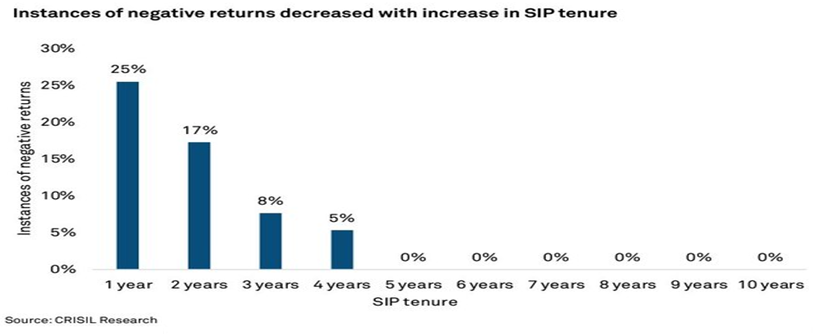
Source: CRISIL. Note that detailed methodology, assumptions, data used, etc. are not available. Hence, below analysis may not be like to like comparison.
This led me to another question. What would this chart look like if we change the criteria from 0% returns, as implied above, to a minimum of 14% returns that is generally expected by an equity investor in India?
To find out if SIP way of investing meaningfully contributes towards generating that 14% annualized returns, we have used Nifty Total Returns Index (TRI) as proxy of equity investments. This thus is from the perspective of an investor investing using “growth” option of MF schemes. Data available is since Jul-1999.
Hence, we have 230 instances where SIP could be started for 1 year, 218 instances where SIP could be started for 2 years…. and 122 instances where SIP could be started for 10 years. (Detailed method is presented in annexure below)
The results are presented as below.
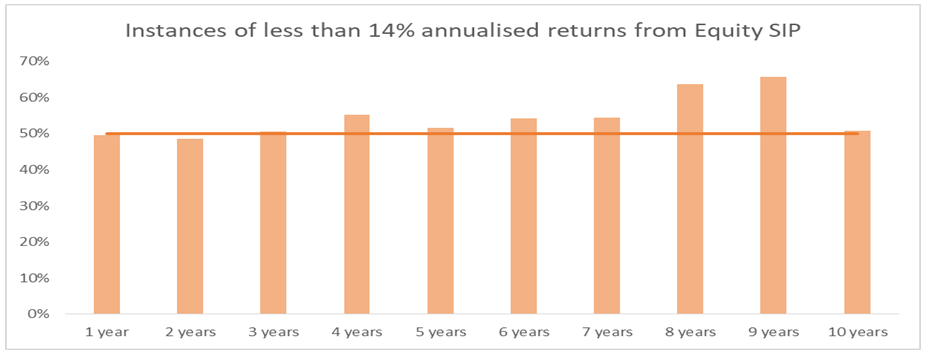
It turns out that making “equity like” returns is largely a game of chance over any time frame with SIPs. None of the time horizon provides any edge to investors.
The odds though keeps on improving as we keep on lowering our returns expectations.
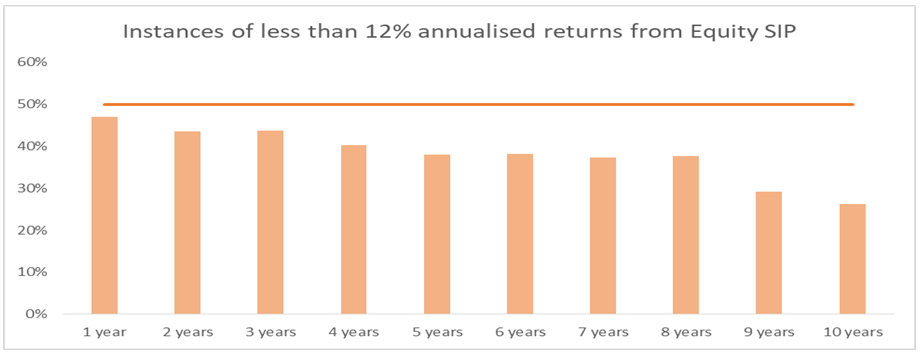
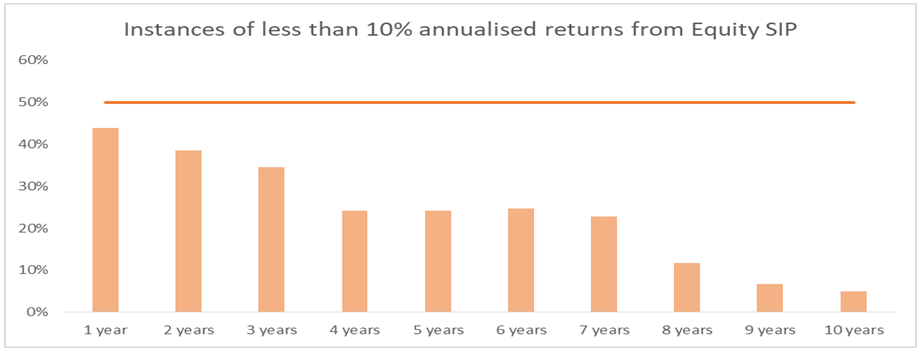
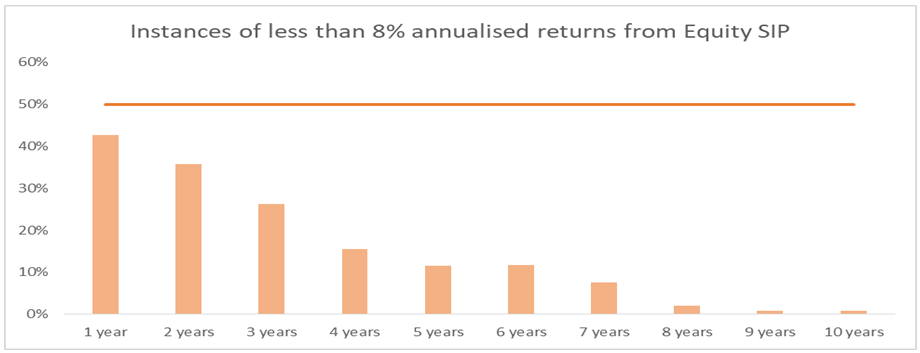
And “instances of negative returns”
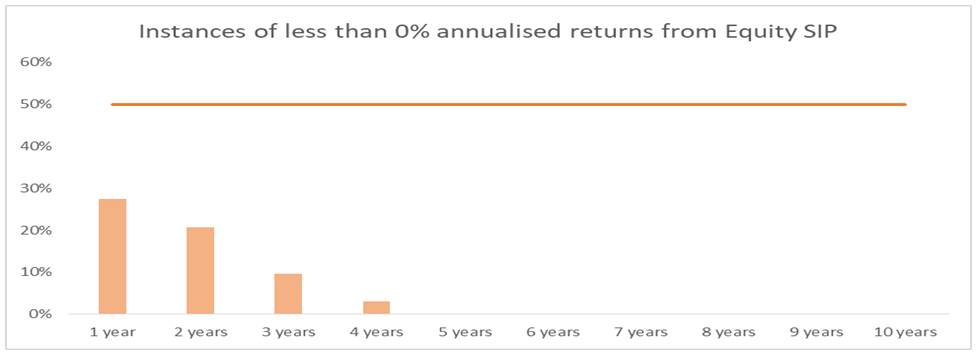
Nearly matches CRISIL’s findings (suggesting similar methodology used for the workings).
It is to be noted that expense ratio and taxes are not considered here. Hence, returns expectations should be adjusted accordingly. Generally, equity mutual fund shaves off ~2% of investment value each year (or around 1.5% for direct plans) and now we also have long term capital gain tax to take care of.
Fund manager’s skills
There have been fund managers who have outperformed benchmark over long term. However, finding such consistent fund managers in itself is a game of chance. Regular studies by S&P’s SPIVA have shown this time and again. (Refer here, here).
Plus there are issues with AUM sizes, fund manager moving to other fund house, etc. also limits fund’s ability to outperform consistently. One can thus get a sense as to why passive investing has took off in the west.
However, it would be interesting to do a similar study on Indian funds with long history. There may be survivor ship bias, changes to mandate, merger of schemes, etc. but might be important to complete this study. We shall try to do the same shortly.
Valuations and Earnings Growth
There also has to be factors beyond just systematic way of investing into equities to achieve that 14% returns. May be valuations and earnings growth during the period of investment also play a big role. We shall try to look into this in our further studies as well.
Returns and Volatility
Additional workings by my colleague Amogh Korde actually brings out a positivity with SIP investing. While median returns remains in the range of 13-14% over any time frame, one can actually lower the standard deviation or variability of returns by increasing his tenure.
In short, SIP can help improve returns expectancy or chances of making money as tenure increases.

To conclude
SIP investments have caught the fancy of Indian investors. It is an “easy” way of investing into equities. Monthly SIP collections are now in excess of USD 1 billion. What essentially it does is that it forces an investor to save and limit behavioral biases when it comes to timing the market. And I do have a hunch that it certainly improves probability for investors of “not losing money” over long term.
However, there appears to be limitation when it comes to making that “equity-like” returns on the investments made. Probability of making money using SIP certainly improves when one’s returns expectations are lower at 10% or 8% with at least 4-5 year’s time horizon. However, in that case, another question arises. Given the risks of high draw downs, volatility in returns and inherent risks associated with equity investing, does it make sense to aim for such low returns out of equities?
Krushi Parekh
Sr. Research Analyst
Sep-2019
Fun-Fact
Instances diminishes as we increase our expectations and time horizon

Note that none of the above should be construed as investment recommendation or advice.
Annexure: Method used
I have used Nifty TRI (Total Returns Index) as proxy of equity Mutual Fund (MF) investment. This thus is also from the perspective of “growth” option of MF.
Step 1: Convert Index level to 100 for Jul-99 since when data for Nifty TRI is available.
Step 2: Assuming Rs 1000 monthly SIP, units that can be purchased for each month are calculated.
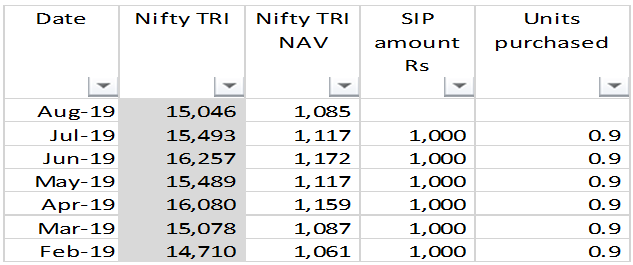
Step 3: 1 year SIP scenario is first taken up. For that, units accumulated over 12 months is calculated based on “Units purchased” column in above table.
Step 4: Using NAV, value of accumulated units is calculated.
Step 5: Value of accumulated units is compared against invested amount to get a sense of absolute returns.

For time horizons >1 year, absolute returns are arrived at using compounding formula ((1+i)^n)-1. Or say for two years ((1+7.3%) x (1+7.3%)) -1 = 15.18%.
Step 6: Since amount is invested over 12 months, it is not appropriate to use CAGR to get a sense if SIP investments has yielded more than annualized returns requirement of 14%. Though IRR comes in the range of 7.2% to 7.6%, for simplicity of our study, I have used average IRR of 7.3% over different time horizons.
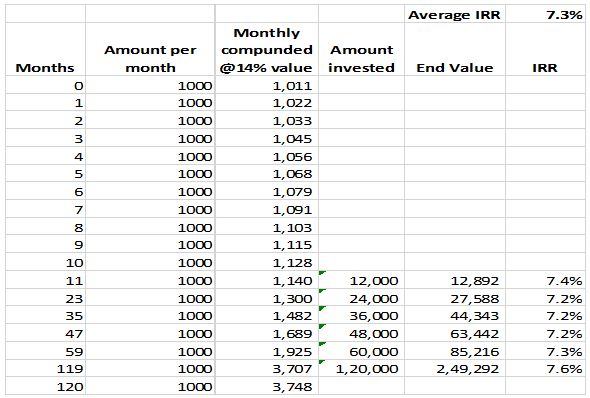
Source: https://multi-act.com/
Queries
-
What is the benefit of mutual fund STP
Aug 29, 2019
-
How much to invest to meet target amount of Rs 2 Crores
Aug 26, 2019
-
Can I achieve my financial goals with my current mutual fund investments
Aug 24, 2019
-
Can you tell me return of various indices
Aug 19, 2019
-
What would be the post tax return on different investments
Aug 18, 2019
-
Which Principal Mutual Fund scheme will be suitable for my retirement corpus
Aug 16, 2019
-
What is the minimum holding period for availing NCD interest
Aug 4, 2019
Top Performing Mutual Funds
Recommended Reading
Fund News
-
Kotak Mahindra Mutual Fund launches Kotak Nifty200 Value 30 Index Fund
Jan 15, 2026 by Advisorkhoj Team
-
Bandhan Mutual Fund launches Bandhan Silver ETF FOF
Jan 12, 2026 by Advisorkhoj Team
-
Bandhan Mutual Fund launches Bandhan Gold ETF FOF
Jan 12, 2026 by Advisorkhoj Team
-
The Wealth Company Mutual Fund launches The Wealth Company Gold ETF FOF
Jan 9, 2026 by Advisorkhoj Team
-
Mahindra Manulife Mutual Fund launches Mahindra Manulife Innovation Opportunities Fund
Jan 9, 2026 by Advisorkhoj Team














